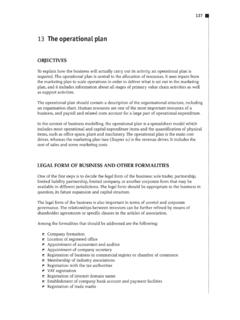Transcription of 10 Generating strategic options - lostlagoon.info
1 10 Generating strategic optionsOBJECTIVESThis chapter addresses the generation of strategic options based on the analysiscovered inprevious chapters. Chapter 18 covers the evaluation and selection of options . The discussion of the generation of strategic options is approached in three steps: The basis for achieving competitive advantage (Michael Porter s generic strategies). Exploring alternative strategic directions. Alternative methods to employ in pursuit of a strategic methodical approach suggested by Garry Johnson and Kevan Scholes has beenadapted by the authors and is shown in Chart Chapter 18 also explains the linkagebetween the portfolio and matrix analysiscovered in Chapter 8 and in this chapter.
2 LINKAGE TO PORTFOLIO AND MATRIX ANALYSISThe industry maturity-competitive position matrix, the growth-share matrix, thedirectional policy matrix and the gebusiness/industry attractiveness screen not onlyanalyse the position of products or strategic business units, but also providerecommendations as to the strategic directions in which strategic business units (sbus)should be example, the recommendation for a problem child sbuis either to develop it by meansof heavy investment or to withdraw it before it becomes a dog. In other words, there aretwo strategic options .
3 The gebusiness/industry attractiveness screen with a three-by-threematrix is even more prescriptive, suggesting only one strategic direction is suitable insome analysis is therefore a useful tool in helping to generate strategic options andChart Generating strategic optionsGeneric strategies Cost leadership Differentiation Cost focus Differentiation focusBASIS OF COMPETITIVEADVANTAGEA lternative directions Development strategies Market penetration Product development Market development Diversification Do nothing Withdrawal Harvesting ExitSTRATEGYDIRECTIONA lternative methods Internal development Acquisition Joint developmentMETHOD OF
4 STRATEGYIMPLEMENTATIONS ource: Adapted from Johnson, G. and Scholes, K. Exploring Corporate Strategy, Prentice-Hall, 198989understand the cash flow implications of strategic decisions for a portfolio of advantage is that the strategies for several products orsbus are looked at not inisolation but in the context of a business with limited resources, which should be allocatedto the products orsbus that produce the greatest return on OF COMPETITIVE ADVANTAGEG eneric strategiesMichael Porter1identified three generic strategies: cost leadership, differentiation and focus strategy has two variants.
5 Cost focus and differentiation focus (see Chart ).Cost leadershipCost is of overwhelming strategic importance. This is implicit in many of the portfolio ormatrix models. Cost leadership strategy aims to reduce the firm s costs at all stages of thevalue chain. This will allow it to earn a higher return on the early stages of the product life cycle, experience-curve-driven reductions in costs areimportant for attaining cost leadership. For a cost leadership strategy to work in the longerterm, volume is usually important. This means that products must address a wide are often standardised to bring down prices and appeal to a wide market.
6 Inindustries where scale economies matter, market share will be a key objective. In terms ofthe growth-share matrix, a cost leadership strategy is an option for stars and cash industries with high fixed costs, capacity utilisation has to be maximised. For example,a cellular mobile phone operator usually has to cover a whole country, so driving upcustomer numbers is of overriding importance in order to increase utilisation and bringChart Generic strategiesSource: Porter, , Competitive Advantage, Free Press, 1980 COMPETITIVE ADVANTAGEL ower costDifferentiationCOMPETITIVE SCOPEN arrow targetBroad target1.
7 Cost leadership2. Differentiation3a. Cost focus3b. Differentiation focus10. Generating strategic OPTIONS90down average costs. In the airline industry, low-cost carriers that apply yield-managementtechniques with the objective of full capacity and short turnaround times are moreprofitable than traditional full-service cost leadership can only be achieved by one firm in the industry. However, given thelaw of diminishing returns, once volumes exceed certain levels, cost differences amongleading businesses will be small. In other words, once a certain scale has been reached nofurther cost advantages may be available.
8 The scalability of a business is therefore animportant differentiation strategy is based on equipping a product or service with some perceivedor tangible unique attribute that cannot be easily replicated by competitors. Perceiveddifferentiation can be achieved, for example, through branding. High quality is acommonly used way to differentiate a smaller supplier from a volume-driven , the differentiation strategy mustbe applied consistentlyat all stages of the valuechain. A quality product can lose its reputation if delivery and installation are shoddy, or ifdistribution is only through stores that are located in downmarket areas.
9 In order to be ofvalue, the cost of differentiation must be lower than the premium buyers are prepared topay for the differentiated is a strategic option for followers, rather than for market leaders. Forexample, if a product is a problem child, the firm could invest to catch up with the strategy is more risky than investing to differentiate the product for two reasons. First,the market leader probably has a cost advantage, which will make it more difficult for thefollower to catch up. Second, a differentiation strategy does not directly challenge themarket leader and therefore reduces the chances of a damaging competitive response, suchas cutting objective of a focus strategy is to gain competitive advantage by building onadvantages of segment-specific specialisation, such as a better understanding of therequirements of buyers in that segment and the ability to respond to particularities ofbuyers.
10 It is also referred to as a niche strategy. Pursuit of a niche strategy amounts tochoosing a competitive playing field where competitive advantage can be achieved. Inpursuing this niche strategy, for this special group of buyers the firm aims to be the best supplier. Within the chosen segment, the firm can achieve competitive advantage eitherbecause it is the cost leader or because it offers a differentiated product. Hence the twovariants of the focus required to pursue generic strategiesDepending on the characteristics of the firm, industry and markets, not all strategies maybe a realistic option.









